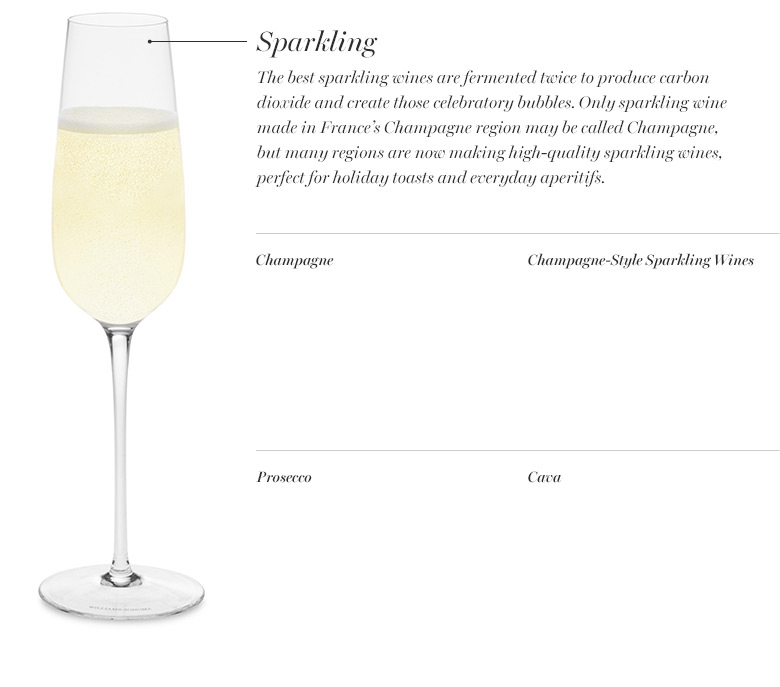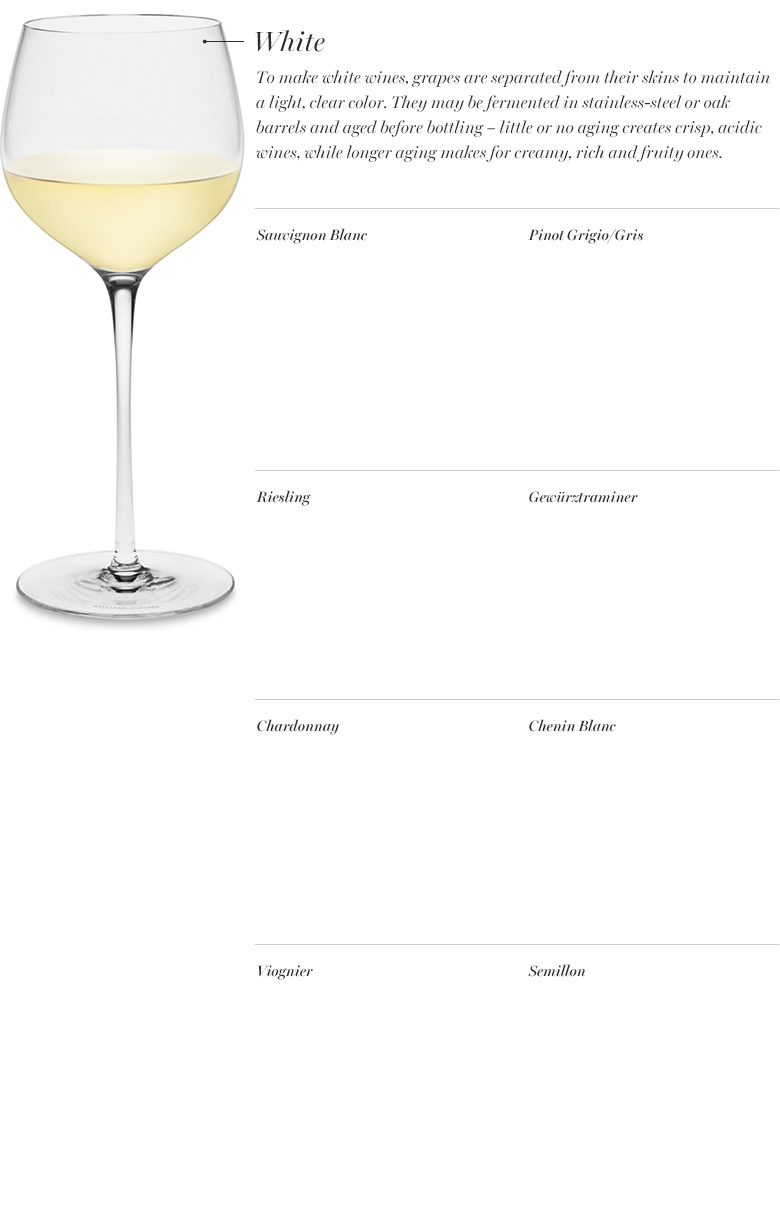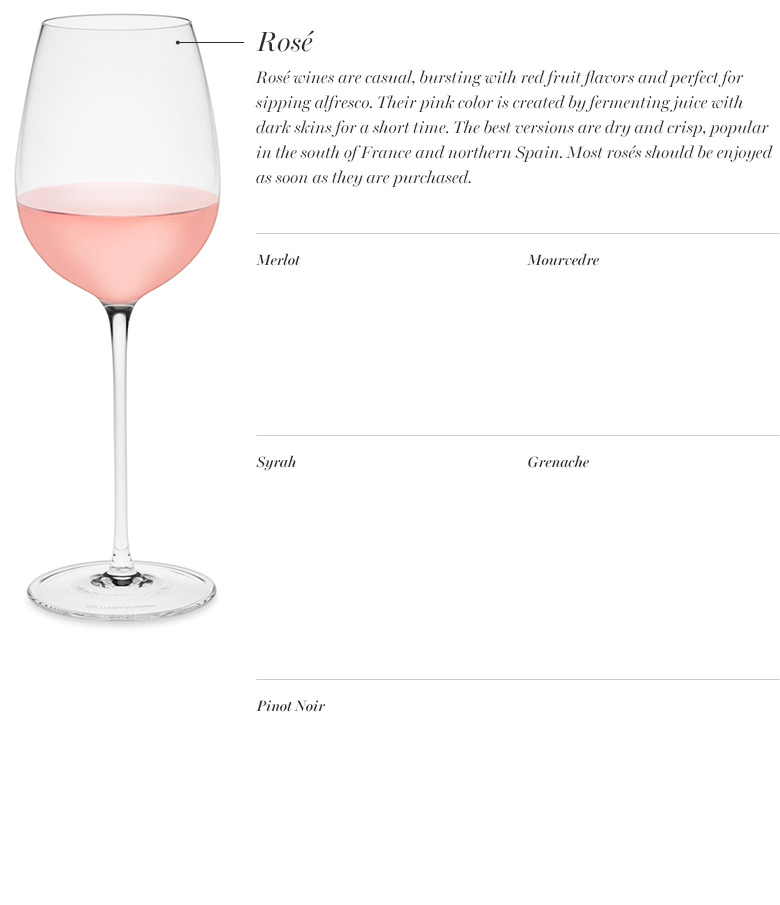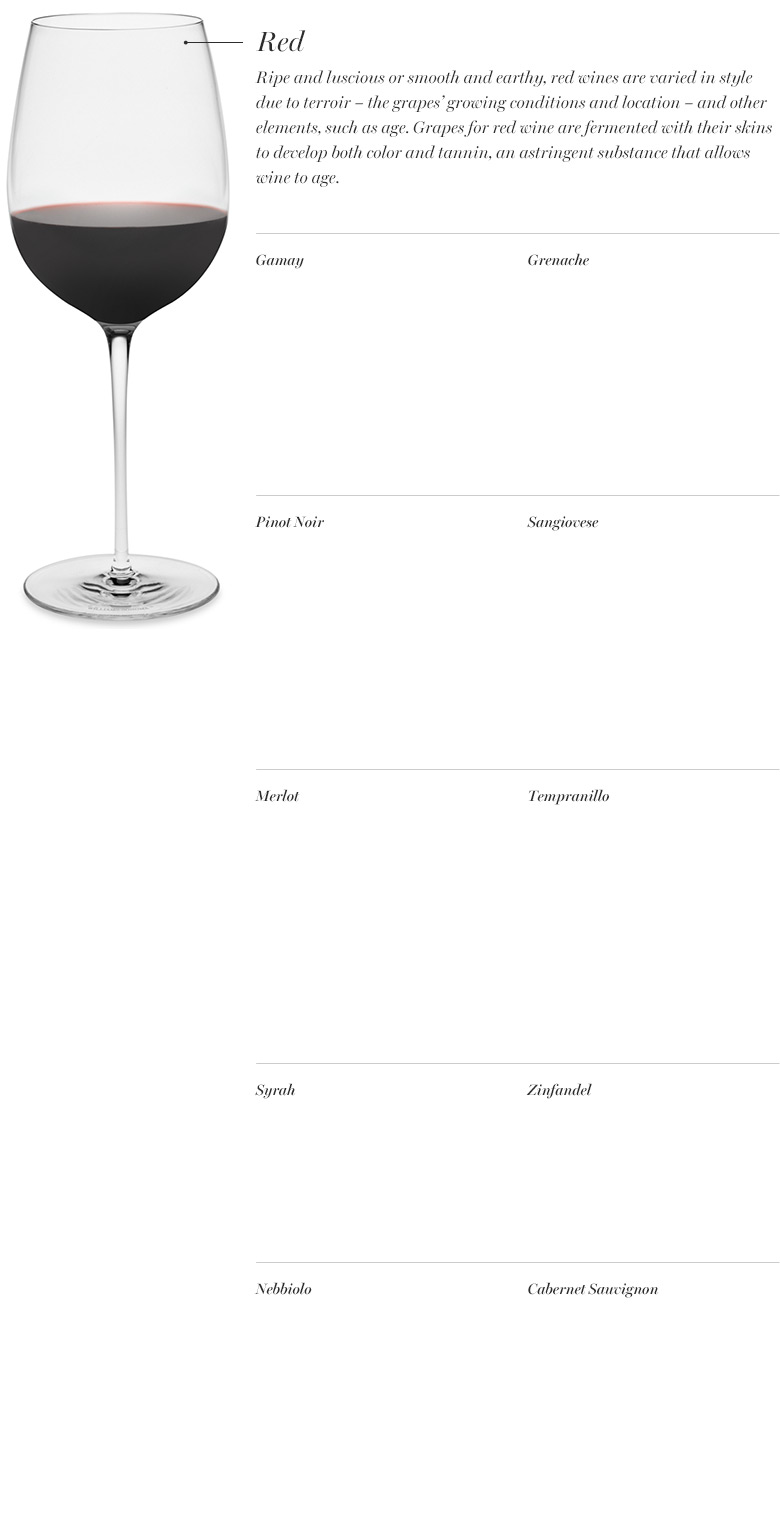
Learn everything you need to know about wine, from grape varietals and growing regions to tasting, serving and pairing with food.


 Shop sparkling wine glasses >
Shop sparkling wine glasses >
Champagne must be made from specific grapes — Chardonnay, Pinot Noir and Pinot Meunier — in the traditional method of fermentation. It comes in two styles: vintage, from grapes of a single year, and nonvintage, made by blending wines from several years.
Tasting notes: yeast, lemon, toast
Regions: France (Champagne)
The same traditional grapes and methods are also used in other regions to make high-quality sparkling wines that rival their French cousins.
Tasting notes: apple, pear, toast
Regions: California, Australia (Tasmania), New Zealand, South Africa
Prosecco refers to both the grape and the wine made in Italy. It has a fruity bouquet and light body, with none of the toasty and yeasty aromas common in Champagne.
Tasting notes: apple, pear, mineral
Regions: Italy (Veneto)
This Spanish sparkling wine uses a traditional method but is made from different native grapes, including Macabeo, Parellada and Xarel-lo. It has a similar yeasty aroma to Champagne and is usually much lower in price. Cavas can also be found as rosés.
Tasting notes: hazelnut, lemon, toast
Regions: Spain

 Shop white wine glasses >
Shop white wine glasses >
This versatile grape is crisp and elegant. French versions from the Loire Valley (labeled Pouilly Fumé and Sancerre) are often herbaceous, while New World wines from California's Napa, Sonoma and Mendocino regions are grassy, with less minerally
aromas.
Tasting notes: herbs, grapefruit, grass
Regions: California, Washington, France (Loire Valley), New Zealand, Chile, Australia, South Africa, Italy
Italian Pinot Grigio is light and easy-drinking, and the grape has become popular in California, too. The French make a softer, more aromatic version known by its French name, Pinot Gris.
Tasting notes: apple, mineral, lemon
Regions: Italy, France, California
High-acid Riesling thrives in cool climates. Known as Germany's greatest contribution to the wine world, it is often made into dessert wines from late-harvest grapes. Alsace, France also makes these wines.
Tasting notes: peach, floral, lemon
Regions: Germany (Rhine), France (Alsace), California, Washington, New York (Finger Lakes), Australia
A distinctive grape, Gewürztraminer is known for its spicy aromas and flavors. It has a darker color than other whites and, like Riesling, thrives in cool climates. Gewürztraminer can also make wonderful dessert wines.
Tasting notes: peach, floral, apricot
Regions: France (Alsace), Germany, Austria, California, Oregon, New Zealand
Burgundy's famed white wines are made with the Chardonnay grape, and is complex with subtle oak flavors. It has a diverse range of flavors and aromas, depending on winemakers' styles and the use of oak. Chardonnay is the primary grape used in Champagne and Champagne-style wines.
Tasting notes: toast, butter, vanilla
Regions: France (Burgundy), California (Napa & Sonoma), Australia, Chile, South Africa
Chenin Blanc adapts well to different soils and climates and in France's Loire Valley, it makes a soft white wine. It has an appealing fruit-forward style in other regions where it is grown.
Tasting notes: melon, kiwi, lemon
Regions: France (Loire Valley), California, Australia, New Zealand, South Africa
Previously only grown in France, Viognier's popularity has expanded in recent years to give it almost cult status. It makes a dry wine with ripe flavors, delicate aromas and a honeyed finish. Like Chardonnay, it often has a significant oak influence, a buttery mouthfeel and a higher alcohol content.
Tasting notes: peach, cream, pear
Regions: France (Rhone Valley), California, Oregon, Washington, Virginia, Italy (Tuscany), Austria
Semillon is usually blended with Sauvignon Blanc in France and with Chardonnay in California. However, it can produce some lovely full-varietal wines, with tropical fruit flavors and spicy, toasty notes.
Tasting notes: melon, cream, pear
Regions: France (Bordeaux), Australia, California, Washington

 Shop wine glasses >
Shop wine glasses >
Dry rosés made from Merlot are common in France's Bordeaux region and are now being made in California as single varietal rosés and blends.
Tasting notes: pomegranate, cherry, cranberry
Regions: France (Bordeaux), California
Mourvedre is the primary grape used in the wines of Bandol in northern Provence, producing a dry, crisp rosé. It may be blended with Grenache, Syrah and other grapes.
Tasting notes: dried cherry, raspberry, cranberry
Regions: France (Bandol)
Syrah is typical in many of the rosés of France, often blended with other local grapes. It's made as a single-varietal rosé in France's Languedoc region, where it may be dry and crisp or fruity and full-bodied. While Syrah's typical barnyard aromas do not show in a rosé, the wine is still imbued with spice.
Tasting notes: strawberry, raspberry, cranberry
Regions: France (Rhone & Languedoc), California, Australia
Southern France and Spain grow Grenache well, thanks to their warm climates. The ripe grapes make rosés with bright fruit and full mouthfeels; in Spain, they are known as rosados, and the grape is called Garnacha.
Tasting notes: raspberry, grapefruit, strawberry
Regions: France (Tavel), Spain (Rioja & Navarra), California
Pinot Noir is made in two styles in the Old World: refined and fruity in Burgundy, and brisk and low-alcohol in the Loire Valley. In the New World, California produces elegant Pinot Noir rosés as well.
Tasting notes: quince, floral, strawberry
Regions: France (Marsennay & Sancerre), California (Napa, Sonoma & Santa Barbara)

 Shop red wine glasses >
Shop red wine glasses >
Gamay is the primary grape in the wines of Beaujolais in France, which come in two styles: Beaujolais Nouveau and Cru Beaujolais. The release of the Beaujolais Nouveau every November creates plenty of excitement in Paris and even in the United States. Gamay is marked by its red-berry fruit, best when enjoyed young; it is a great value when compared to other reds.
Tasting notes: strawberry, banana, raspberry
Regions: France (Beaujolais)
Known for aromas of ripe red fruit and lavender, Grenache is used often in blends from southern France. Adding Syrah and Mourvèdre gives the wine more structure.
Tasting notes: raspberry, lavender, cherry
Regions: France (Côtes-du-Rhône), Australia
Pinot Noir may be juicy and red in French Old World wines, or smooth and fruit-forward in the New World, particularly California and Oregon. More recent vintages are juicy, with little or no oak, while wines labeled "Grand Cru" or "Premier Cru" are more complex. These wines pair particularly well with a variety of foods.
Tasting notes: raspberry, lavender, blackberry
Regions: France (Burgundy, Alsace, Loire), California (Sonoma, Napa & Santa Barbara), Oregon (Willamette Valley), New Zealand, Australia, Chile
Versatile Sangiovese can make a bold Brunello or a spicy, smooth Tuscan blend. It's also the primary grape used to make Chianti. Sangiovese may be tart when unblended, but its high acid content stands up well to tangy tomato sauces and rich cheeses.
Tasting notes: raspberry, star anise, dried cherry
Regions: Italy (Tuscany), California, Argentina
Popular in Bordeaux, France, Merlot makes a traditional silky, earthy wine, but newer examples from the Napa Valley also bring concentrated fruit flavors and dark chocolate to the center stage. It's a great wine for those who like Cabernet Sauvignon's general flavor profile but not Cabernet's harsher flavors and texture. It's ready to drink almost as soon as it's bottled.
Tasting notes: plum, blackberry, green bell
pepper
Regions: France (Bordeaux), Italy, California (Napa Valley), Washington, Chile, Australia
Tempranillo is Spain's most important red wine grape, particularly in the Rioja region. Many describe it as leathery and dusty, a reflection of the wine's terroir and oak aging, with hints of red fruit.
Tasting notes: cinnamon, star anise, dried cherry
Regions: Spain (Rioja), Portugal, California, Argentina
Syrah may be made in the French style, which is earthy with dark fruit and tannins; or in the Australian style (Shiraz), which is robust and jammy. It has musky overtones and holds up well to spicy foods and bold flavors.
Tasting notes: plum, blackberry, clove
Regions: France (Rhône) Australia, California
Widely planted in California, Zinfandel is known for its intense, concentrated fruit flavors. It may be very high in alcohol, but it is accessible, with less intense tannins and good acidity – a perfect barbecue wine.
Tasting notes: black pepper, blackberry, clove
Regions: California
Some of the most prized wines of Italy are made from the Nebbiolo grape, such as Barolo and Barbaresco. Barolo features dark fruit and high tannins and can age for many years, while Barbaresco is more accessible.
Tasting notes: truffle, dried cherry, cigar
Regions: Italy (Piedmont)
Cabernet Sauvignon gained fame in Bordeaux, France, and also helped establish California as a top wine region. It's a fruit-forward wine with overt oak flavors and dense tannins, ideally suited to aging, which softens its hard edges and mellows its tannins.
Tasting notes: green bell pepper, blackberry, toast
Regions: France (Bordeaux), California, Washington, Chile, Australia

 Shop dessert wine glasses >
Shop dessert wine glasses >
The Muscat grape makes pleasantly sweet wines, some of which are fortified. It can also be found as Moscato d'Asti in northern Italy, a refreshing, low-alcohol sparkling wine.
Tasting notes: dried apricot, floral, honey
Regions: France, Italy (Asti), California, Australia
Semillon is the basis for Sauternes, a prized and rare dessert wine made by leaving Semillon and Sauvignon Blanc grapes on the vine longer than normal to concentrate their sugars. It's only made in years when noble rot, a beneficial fungus, affects the grapes, lending a musty flavor to the wine.
Tasting notes: dried apricot, hazelnut, honey
Regions: France (Bordeaux), California, Australia
Made in central Italy, Vin Santo means "holy wine" and is considered one of the best dessert wines in the world. It is a nutty wine with concentrated fruit, made from Trebbiano and Malvasia grapes.
Tasting notes: fig, dried apricot, caramel
Regions: Italy
There are two kinds of Port: Ruby Port and Tawny Port. The former is blended from a variety of young wines and aged just a few years, resulting in a wine with juicy, fruity flavor. The latter is aged for many years, developing a nutty flavor and caramel color, and tends to be more expensive.
Tasting notes: fig, chocolate, prune
Regions: Portugal









